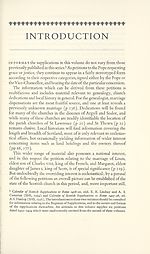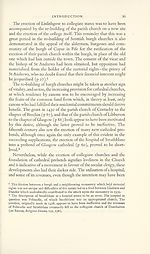Download files
Complete book:
Individual page:
Thumbnail gallery: Grid view | List view

SCOTTISH SUPPLICATIONS TO ROME
an evaluation can be made of papal relations with Scotland at a
juncture immediately prior to the struggles between the crown and
the papacy which were to dominate the rest of the fifteenth century.
As to the state of the Church in general, in one respect it was
flourishing, and the growing importance of collegiate churches, which
are indicative of this, is reflected in these petitions. Bothwell, Dunbar
and St Mary on the Rock, St Andrews, all figure prominently; their
provostships and prebends proving attractive to pluralists who were
anxious to acquire such benefices, which as they did not entail the cure
of souls were free from the restriction placed by canon law on the hold¬
ing of only one benefice to which the cure of souls was attached.
If the growth of pluralism augured ill for the Church, this in no
way deterred prospective founders of collegiate churches from their
purpose. Moreover, it must be admitted that the constitutions of
most such foundations made an attempt, albeit an unsuccessful one,
to prevent pluralism by stipulating fixed periods of residence. The
great spate of such foundations was not to come until later in the
fifteenth century, but in these petitions the king, James i, is to be
found as a leader of fashion in proposing on 7 October, 1430, to erect
a new collegiate church in the burgh of Linlithgow. The vicar of
the parish church was to become the college’s first provost, and
twelve chaplains, as a later petition reveals, were to form its remaining
complement (pp 140,176). Finance for the new institution was to be
forthcoming from the revenues of the parish churches of Calder-
Comitis and Strathbrock, and these endowments were to be further
augmented by the king. Despite these pious intentions, however, the
foundation was never completed. The reason is not clear, but the
death of the king in 1437 is the most likely, although the failure to
find further adequate endowments may have contributed to this end,
which left Linlithgow as an important burgh church containing many
chaplains, but bereft of the constitution which would have made it
fully collegiate.1
1 If Linlithgow never became fully cohegiate, at least an attempt was made in that
direction. The cohegiate church of St Nicholas of Stronsay (p 52), on the other hand,
owes its existence to an error of transcription. The canonry and prebend of ecclesie
collegiate sancti Nicolai de Stronsay is in fact a canonry and prebend of Orkney, the
endowment of which was derived from the revenues of St Nicholas of Stronsay.
This is clearly revealed in a subsequent petition (p 55) in which it is described as the
‘canonry and prebend of church of St Nicholas de Stronsay in the church of Orkney’.
an evaluation can be made of papal relations with Scotland at a
juncture immediately prior to the struggles between the crown and
the papacy which were to dominate the rest of the fifteenth century.
As to the state of the Church in general, in one respect it was
flourishing, and the growing importance of collegiate churches, which
are indicative of this, is reflected in these petitions. Bothwell, Dunbar
and St Mary on the Rock, St Andrews, all figure prominently; their
provostships and prebends proving attractive to pluralists who were
anxious to acquire such benefices, which as they did not entail the cure
of souls were free from the restriction placed by canon law on the hold¬
ing of only one benefice to which the cure of souls was attached.
If the growth of pluralism augured ill for the Church, this in no
way deterred prospective founders of collegiate churches from their
purpose. Moreover, it must be admitted that the constitutions of
most such foundations made an attempt, albeit an unsuccessful one,
to prevent pluralism by stipulating fixed periods of residence. The
great spate of such foundations was not to come until later in the
fifteenth century, but in these petitions the king, James i, is to be
found as a leader of fashion in proposing on 7 October, 1430, to erect
a new collegiate church in the burgh of Linlithgow. The vicar of
the parish church was to become the college’s first provost, and
twelve chaplains, as a later petition reveals, were to form its remaining
complement (pp 140,176). Finance for the new institution was to be
forthcoming from the revenues of the parish churches of Calder-
Comitis and Strathbrock, and these endowments were to be further
augmented by the king. Despite these pious intentions, however, the
foundation was never completed. The reason is not clear, but the
death of the king in 1437 is the most likely, although the failure to
find further adequate endowments may have contributed to this end,
which left Linlithgow as an important burgh church containing many
chaplains, but bereft of the constitution which would have made it
fully collegiate.1
1 If Linlithgow never became fully cohegiate, at least an attempt was made in that
direction. The cohegiate church of St Nicholas of Stronsay (p 52), on the other hand,
owes its existence to an error of transcription. The canonry and prebend of ecclesie
collegiate sancti Nicolai de Stronsay is in fact a canonry and prebend of Orkney, the
endowment of which was derived from the revenues of St Nicholas of Stronsay.
This is clearly revealed in a subsequent petition (p 55) in which it is described as the
‘canonry and prebend of church of St Nicholas de Stronsay in the church of Orkney’.
Set display mode to:
![]() Universal Viewer |
Universal Viewer | ![]() Mirador |
Large image | Transcription
Mirador |
Large image | Transcription
Images and transcriptions on this page, including medium image downloads, may be used under the Creative Commons Attribution 4.0 International Licence unless otherwise stated. ![]()
| Scottish History Society volumes > Series 4 > Calendar of Scottish supplications to Rome, 1428-1432 > (17) Page x |
|---|
| Permanent URL | https://digital.nls.uk/126678435 |
|---|
| Description | Over 180 volumes, published by the Scottish History Society, containing original sources on Scotland's history and people. With a wide range of subjects, the books collectively cover all periods from the 12th to 20th centuries, and reflect changing trends in Scottish history. Sources are accompanied by scholarly interpretation, references and bibliographies. Volumes are usually published annually, and more digitised volumes will be added as they become available. |
|---|


